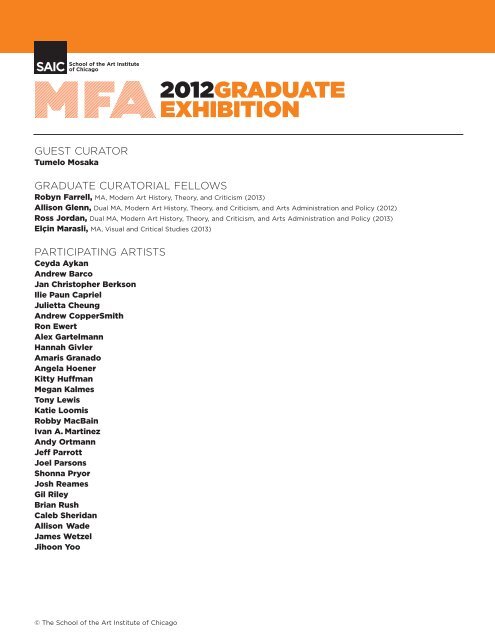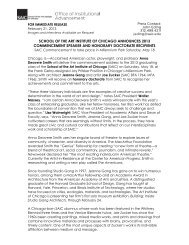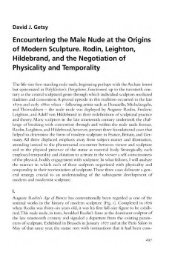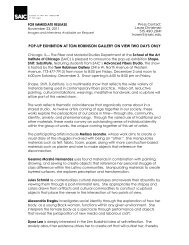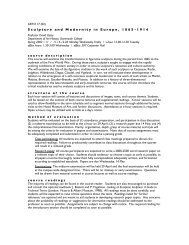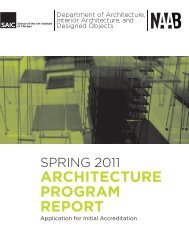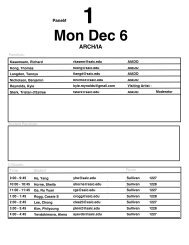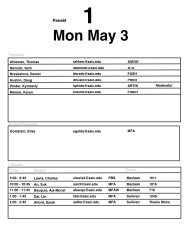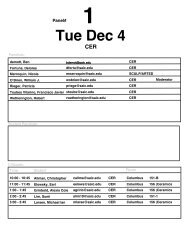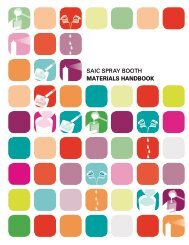2012GRADUATE EXHIBITION - School of the Art Institute of Chicago
2012GRADUATE EXHIBITION - School of the Art Institute of Chicago
2012GRADUATE EXHIBITION - School of the Art Institute of Chicago
You also want an ePaper? Increase the reach of your titles
YUMPU automatically turns print PDFs into web optimized ePapers that Google loves.
GUEST CURATOR<br />
Tumelo Mosaka<br />
GRADUATE CURATORIAL FELLOWS<br />
Robyn Farrell, MA, Modern <strong>Art</strong> History, Theory, and Criticism (2013)<br />
Allison Glenn, Dual MA, Modern <strong>Art</strong> History, Theory, and Criticism, and <strong>Art</strong>s Administration and Policy (2012)<br />
Ross Jordan, Dual MA, Modern <strong>Art</strong> History, Theory, and Criticism, and <strong>Art</strong>s Administration and Policy (2013)<br />
Elçin Marasli, MA, Visual and Critical Studies (2013)<br />
PARTICIPATING ARTISTS<br />
Ceyda Aykan<br />
Andrew Barco<br />
Jan Christopher Berkson<br />
Ilie Paun Capriel<br />
Julietta Cheung<br />
Andrew CopperSmith<br />
Ron Ewert<br />
Alex Gartelmann<br />
Hannah Givler<br />
Amaris Granado<br />
Angela Hoener<br />
Kitty Huffman<br />
Megan Kalmes<br />
Tony Lewis<br />
Katie Loomis<br />
Robby MacBain<br />
Ivan A. Martinez<br />
Andy Ortmann<br />
Jeff Parrott<br />
Joel Parsons<br />
Shonna Pryor<br />
Josh Reames<br />
Gil Riley<br />
Brian Rush<br />
Caleb Sheridan<br />
Allison Wade<br />
James Wetzel<br />
Jihoon Yoo<br />
© The <strong>School</strong> <strong>of</strong> <strong>the</strong> <strong>Art</strong> <strong>Institute</strong> <strong>of</strong> <strong>Chicago</strong><br />
<strong>2012GRADUATE</strong><br />
<strong>EXHIBITION</strong>
<strong>Art</strong>ists’Voices<br />
Curatorial Fellows: The MFA show is<br />
unusual in that you work without knowing<br />
<strong>the</strong> intended space for your <strong>the</strong>sis<br />
project. How has <strong>the</strong> process <strong>of</strong> <strong>the</strong> MFA<br />
show affected your method, and how<br />
has it prepared you for <strong>the</strong> next steps in<br />
your artistic career? What advice would<br />
you <strong>of</strong>fer to future MFA students as <strong>the</strong>y<br />
approach <strong>the</strong>ir MFA show?<br />
Ron Ewert: Last semester Terry Myers<br />
explained to me his <strong>the</strong>ory <strong>of</strong> <strong>the</strong> "Big<br />
Red Bow Myth." He said that artists in<br />
grad programs <strong>of</strong>ten envision presenting<br />
<strong>the</strong>ir work as a perfectly finished, definitive<br />
statement, ready for sale and representation,<br />
which is essentially impossible<br />
in an intensive self-critical, two-year program.<br />
Instead he suggested being honest<br />
with oneself and continuing to work<br />
towards <strong>the</strong> core <strong>of</strong> your practice, simply<br />
presenting <strong>the</strong> strongest work at <strong>the</strong> time<br />
<strong>of</strong> <strong>the</strong> show. After all, <strong>the</strong>re will be more<br />
and more important shows in <strong>the</strong> future.<br />
I tend to look at <strong>the</strong> MFA show as a celebratory<br />
moment, one in which artists are<br />
inherently vulnerable, showing work on<br />
<strong>the</strong> precipice <strong>of</strong> artistic maturity, at a<br />
moment full <strong>of</strong> potential. Its kind <strong>of</strong> like<br />
football players dancing in <strong>the</strong> end zone<br />
after a touchdown: while endlessly entertaining,<br />
it’s better to act like you've been<br />
<strong>the</strong>re before and are confident you'll get<br />
<strong>the</strong>re again.<br />
Ron Ewert<br />
DK, 2012<br />
Acrylic on linen<br />
Angela Hoener: This show prepares one<br />
to react to a real setting by confronting<br />
two opposite forces: projecting fully one's<br />
artistic voice, while considering how your<br />
work might adapt to making a public<br />
statement, being on public view. I think it<br />
is important and vital to temper <strong>the</strong>se<br />
two opposing positions for <strong>the</strong> longevity<br />
<strong>of</strong> one’s career. My future advice is to just<br />
stay and be present!<br />
Caleb Sheridan: I would start by saying<br />
not knowing <strong>the</strong> floor plan for <strong>the</strong> MFA<br />
show makes an artist consider many different<br />
possibilities in regard to <strong>the</strong> presentation<br />
format and what work to chose<br />
for <strong>the</strong> exhibition. It also makes <strong>the</strong> artist<br />
conscious and considerate <strong>of</strong> compromises<br />
to help <strong>the</strong> overall vision <strong>of</strong> a really<br />
vast group show.<br />
My advice for future MFA candidates<br />
is to create work you believe in and make<br />
a good amount <strong>of</strong> work, so when changes<br />
in <strong>the</strong> process occur, you can adapt as<br />
seamlessly as possible. Even though your<br />
work will change through <strong>the</strong> process, try<br />
to be as clear with your curators about<br />
what you need for <strong>the</strong> show, spatially, so<br />
<strong>the</strong>y can help you as <strong>the</strong> individual artist<br />
while formulating <strong>the</strong> vision for <strong>the</strong> overall<br />
exhibition. Also, for MFA candidates,<br />
remember that it's your show, so even<br />
though compromises need to be made,<br />
make sure you stick to your vision and<br />
don't let <strong>the</strong> mass curatorial process completely<br />
dictate your aes<strong>the</strong>tic and layout.<br />
Allison Wade: Since my work is sitedependent<br />
and not site-specific, not<br />
knowing <strong>the</strong> particular exhibition space<br />
did not affect <strong>the</strong> first part <strong>of</strong> my process:<br />
<strong>the</strong> making. However, not knowing<br />
became a challenge for <strong>the</strong> second—<br />
equally significant—part <strong>of</strong> my process:<br />
<strong>the</strong> arranging.<br />
I create groups <strong>of</strong> sculptures and<br />
emphasize particular relationships<br />
through installation, positioning works so<br />
that visual and physical connections<br />
punctuate one’s navigation <strong>of</strong> space.<br />
Negative space is a critical component <strong>of</strong><br />
my compositions, <strong>of</strong>ten as important as<br />
<strong>the</strong> more materially substantial elements.<br />
In a large group show with over one<br />
Allison Wade<br />
Eight Hundred, 2012<br />
mixed media<br />
hundred artists, space <strong>of</strong> any kind is at a<br />
premium. Advocating for negative space<br />
can be tricky, especially if you don’t have<br />
a final composition in mind, because <strong>the</strong><br />
composition will depend on <strong>the</strong> space—<br />
a bit <strong>of</strong> a Catch-22.<br />
Since I was coming to <strong>the</strong> show<br />
without a fixed arrangement, I had to<br />
determine my must-haves in terms <strong>of</strong> a<br />
final space assignment. For me <strong>the</strong>se<br />
were: enough negative space, <strong>the</strong> safety<br />
<strong>of</strong> <strong>the</strong> objects (since <strong>the</strong>y are so precarious,<br />
which is part <strong>of</strong> <strong>the</strong> content), and<br />
certain lighting conditions. My curatorial<br />
fellow listened to <strong>the</strong>se concerns and<br />
came up with a workable solution. So, my<br />
advice to future grads is to know <strong>the</strong><br />
absolute essentials for showing your<br />
work, while remaining somewhat flexible.<br />
Plus, keep <strong>the</strong> dialogue open with your<br />
guest curator and curatorial fellows, as<br />
well as with <strong>the</strong> artists around you.<br />
Josh Reames: I think <strong>the</strong> experience has<br />
been a little different for me than it has<br />
been for a lot <strong>of</strong> o<strong>the</strong>rs, as based on a<br />
couple years <strong>of</strong> observing stress levels
<strong>Art</strong>ists’Voices<br />
Jan Christopher Berkson<br />
La Petit Mort, 2012, acrylic on canvas<br />
during MFA show time. Both Ron [Ewert]<br />
and I have approached <strong>the</strong> show with a<br />
level <strong>of</strong> flexibility; we know <strong>the</strong> gist <strong>of</strong><br />
what we want to do, but knew going into<br />
it that <strong>the</strong>re were all sorts <strong>of</strong> contingencies<br />
to maneuver—space, curator's<br />
visions, how our stuff would operate in<br />
proximity with o<strong>the</strong>r artist's work, etc. My<br />
best advice is to be as flexible as possible<br />
and make tons <strong>of</strong> art; <strong>the</strong>n hanging <strong>the</strong><br />
show becomes more about selection and<br />
curation.<br />
Katie Loomis: It's an organic process that<br />
allows you to focus your time in <strong>the</strong> studio<br />
creating work, while <strong>the</strong> curatorial<br />
team molds and shapes <strong>the</strong> MFA exhibition.<br />
It's about being receptive and allowing<br />
<strong>the</strong> work to speak for itself.<br />
Jeff Parrott: To be honest getting ready<br />
for <strong>the</strong> MFA show has been exciting and<br />
down right frightening. One minute a<br />
painting seems right for <strong>the</strong> show, only<br />
to be set aside by a newer painting. It's a<br />
battle, constantly cycling, never to be<br />
satisfied with what’s been created, but<br />
ra<strong>the</strong>r satisfied only when creating and in<br />
<strong>the</strong> moment <strong>of</strong> not-really-sure-what-is-<br />
being-painted-is-really-even-worth-showing<br />
for this big show. It's as if one would<br />
be ready only when <strong>the</strong> deadline <strong>of</strong><br />
installing one’s work hits, and this obsessive<br />
cycle <strong>of</strong> constantly working will get<br />
silenced within. Even <strong>the</strong>n, one still might<br />
never be satisfied with <strong>the</strong> work created<br />
to show <strong>the</strong> public. But in <strong>the</strong> end what<br />
one has learned is maybe a better understanding<br />
<strong>of</strong> one’s own intuition or even<br />
new painting techniques. This once-in-alifetime<br />
experience—preparing for <strong>the</strong><br />
MFA show—boils down to one notion as<br />
an artist: "I know nothing and in this nothing<br />
is all."<br />
Jan Christopher Berkson: At first I was a<br />
little anxious not knowing where or how<br />
much space I would have and, <strong>of</strong> course,<br />
everyone wants to be in a highly visible<br />
spot. But within <strong>the</strong> first couple meetings<br />
with <strong>the</strong> curatorial team, I decided <strong>the</strong>y<br />
had my best interests in mind, so I was<br />
going to try and not worry, but instead<br />
keep painting until <strong>the</strong> last possible<br />
moment. As shifts in my work occurred I<br />
kept my curatorial fellows apprised, so<br />
any possible adjustments could be made<br />
within <strong>the</strong> limitations <strong>of</strong> <strong>the</strong> gallery and in<br />
Jihoon Yoo<br />
still from Rehearsal #1-2, 2012, 3D animation<br />
relation to <strong>the</strong> o<strong>the</strong>r artists nearby. With<br />
advice from <strong>the</strong> team, I felt free to continue<br />
to pursue what I was interested in, but<br />
knew that it might affect placement <strong>of</strong><br />
<strong>the</strong> work. This made me more mindful <strong>of</strong><br />
which direction to go when it came to<br />
putting in works/creating more works<br />
that would be in conversation with each<br />
o<strong>the</strong>r. I think this experience has influenced<br />
me to be more thoughtful in terms<br />
<strong>of</strong> <strong>the</strong> interrelatedness <strong>of</strong> developing<br />
work and curating. This is a good thing to<br />
think about when working towards a<br />
graduate exhibition.<br />
Jihoon Yoo: In order to be an artist, you<br />
must be open and willing to experiment<br />
with many unique possibilities. Being<br />
unfamiliar with <strong>the</strong> space allowed me to<br />
focus more on my project and less on its<br />
surroundings. <strong>Art</strong>ists should treat <strong>the</strong>ir<br />
work like an organic entity, enabling it to<br />
adapt to its surroundings.
Studio Visits<br />
In-Between Spaces <strong>of</strong> Experience<br />
by Elçin Marasli<br />
A dialogue on <strong>the</strong> artist’s studio, first and<br />
foremost, demands an unconventional<br />
definition <strong>of</strong> <strong>the</strong> word “space.” While<br />
ideas tend to plant seeds inside <strong>the</strong><br />
artist’s mind, <strong>the</strong> work itself needs physical<br />
recognition inside a space—be it an<br />
art object, a digital projection, or a performative<br />
event. The studio is where <strong>the</strong><br />
artist delivers <strong>the</strong> art, and where <strong>the</strong> art,<br />
manifests its existence. The resulting<br />
definition <strong>of</strong> <strong>the</strong> studio space, <strong>the</strong>refore,<br />
constructs an aes<strong>the</strong>tic/<strong>the</strong>oretical entity;<br />
it is a space in-between.<br />
The studio visits we scheduled on <strong>the</strong><br />
second weekend <strong>of</strong> February consisted <strong>of</strong><br />
highly energized exchanges between<br />
curatorial voices and artistic needs. Under<br />
<strong>the</strong> insightful guidance <strong>of</strong> our guest curator<br />
Tumelo Mosaka, our well-organized<br />
team visited each <strong>of</strong> our thirty artists and<br />
turned a sunny weekend into three full<br />
days <strong>of</strong> constructive exchange inside <strong>the</strong>ir<br />
studio spaces. While we were walking in<br />
and out <strong>of</strong> each studio, with notebooks in<br />
our hands and expectations on our minds,<br />
our artists also carried with <strong>the</strong>m snippets<br />
Julietta Cheung<br />
sketch <strong>of</strong> proposed installation for An Index <strong>of</strong> Material Moments, 2012<br />
<strong>of</strong> curious anxiety. Some were hesitant to<br />
talk to us in detail about <strong>the</strong>ir works,<br />
while some were more courageous in<br />
directing <strong>the</strong>ir questions at us, challenging<br />
us with definitions <strong>of</strong> curatorial<br />
practice. It did not take too long, however,<br />
for <strong>the</strong> first few minutes <strong>of</strong> each visit<br />
to transition from formal introductions<br />
into friendly dialogue. Throughout <strong>the</strong><br />
curatorial process each <strong>of</strong> <strong>the</strong> fellows<br />
followed up with <strong>the</strong>ir artist-subgroups,<br />
making studio visits to keep communications<br />
open. By entering <strong>the</strong> artists’<br />
spaces, we were able to bridge connections<br />
between <strong>the</strong>ir personalities, <strong>the</strong>ir<br />
artistic philosophies and techniques, and<br />
<strong>the</strong>ir expectations and needs. It was<br />
only this idea <strong>of</strong> <strong>the</strong> studio as a space<br />
in-between that allowed <strong>the</strong> curatorial<br />
perspective to merge into <strong>the</strong> artistic<br />
experience, and vice versa.<br />
Having studio visits as <strong>the</strong> primary<br />
building block <strong>of</strong> our process <strong>of</strong> putting<br />
toge<strong>the</strong>r <strong>the</strong> MFA exhibition, allowed<br />
us to match our curatorial tasks to<br />
<strong>the</strong> innovative methodologies <strong>of</strong> studio<br />
Spreadsheet showing schedule <strong>of</strong> <strong>the</strong> curatorial<br />
team’s studio visits<br />
Image: Ross Jordan
Studio Visits<br />
In-Between Spaces <strong>of</strong> Experience<br />
by Elçin Marasli<br />
production. It was not surprising to watch<br />
<strong>the</strong> curatorial process successfully unfold<br />
only after having <strong>the</strong> opportunity to<br />
understand our artists as individuals<br />
inside <strong>the</strong>ir studios, and later to communicate<br />
with <strong>the</strong>m about <strong>the</strong>ir particular<br />
needs as <strong>the</strong>y evolved from within <strong>the</strong>ir<br />
private spaces into <strong>the</strong> public gallery. In<br />
her essay “Live/Work,” Katy Siegel utilizes<br />
<strong>the</strong> metaphor <strong>of</strong> an “apartment” to refer<br />
to an artist’s studio. 1 This made me think<br />
that one creative way for audiences to<br />
approach <strong>the</strong> MFA exhibition would be to<br />
realize it as an experiential site for<br />
viewing and living art. Our curatorial task<br />
has been along <strong>the</strong>se lines—bridging<br />
communities and allowing <strong>the</strong>m to share<br />
and live between spaces <strong>of</strong> experience.<br />
Fully embracing what this show has to<br />
<strong>of</strong>fer, we can enter into an experience <strong>of</strong><br />
<strong>the</strong> work that has been created inside <strong>the</strong><br />
artist’s studio; we can analyze <strong>the</strong> work in<br />
<strong>the</strong> gallery setting; and we can live <strong>the</strong><br />
experience that will only keep growing in<br />
between <strong>the</strong>se two spaces <strong>of</strong> studio and<br />
exhibition.<br />
1 Katy Siegel, “Live/Work,” in The Studio Reader: On <strong>the</strong><br />
Space <strong>of</strong> <strong>Art</strong>ists, ed. Mary Jane Jacob and Michelle<br />
Grabner (<strong>Chicago</strong>: University <strong>of</strong> <strong>Chicago</strong> Press, 2010)<br />
Curatorial Fellow Elçin Marasli at studio visit<br />
with artist Julietta Cheung<br />
Photo: Robyn Farrell
Studio Visits<br />
Role Play<br />
by Ross Jordan<br />
All studio visits pretty much start with<br />
someone, visitor or invitee, asking, “So,<br />
I’m not sure what you want me to do?” or<br />
“It’s good to see you, why are we<br />
talking?” It seems too presumptuous and<br />
forward to begin with, “So let’s see some<br />
art!”—as if being on a first date and<br />
suggesting that dinner be skipped for <strong>the</strong><br />
delights <strong>of</strong> dessert. Is it rare that something<br />
so important is so poorly understood?<br />
Studio visits are like sketch<br />
comedies: everyone has a role (artist,<br />
curator), but no one knows what is<br />
happening until someone just decides<br />
what should happen. But even so, <strong>the</strong><br />
roles need to be ironed out. The studio<br />
visits for <strong>the</strong> MFA show are <strong>the</strong> process<br />
<strong>of</strong> young curators and artists getting to<br />
know <strong>the</strong>ir roles. As a burgeoning curator,<br />
I immediately feel like I needed to say<br />
something important that conveys my<br />
presumed talent in my role. But I have<br />
found I usually have little to say as I listen<br />
to an artist talk about nascent ideas,<br />
referring to sketches and prototypes.<br />
Nine times out <strong>of</strong> ten, so many things<br />
rush into my head that I’m frozen. When<br />
looking at art in someone’s studio many<br />
connections, threads <strong>of</strong> thought, and<br />
eureka moments are available. It’s hard to<br />
know where to start. I want to give <strong>the</strong><br />
right advice, as well as posing criticism<br />
and questions. I also don’t want to let on<br />
that I have no idea what I’m doing.<br />
I freeze because I realize nothing<br />
I have done after four years <strong>of</strong> undergraduate<br />
sculpture and a-year-and-a-half<br />
<strong>of</strong> graduate school has prepared me to<br />
give advice about <strong>the</strong> creation <strong>of</strong><br />
artworks. This is a curious moment,<br />
because shouldn’t something so important<br />
to curatorial practice at least<br />
have a lecture series or a half-credit<br />
course where I could think about what a<br />
good studio visit should be like? Instead<br />
I’m learning my role through direct<br />
experience by performing my role. I’m<br />
flying by <strong>the</strong> seat <strong>of</strong> my pants.<br />
The artist has fulfilled <strong>the</strong>ir role and<br />
made art and shared it with me. Now<br />
I have to be courageous myself, play my<br />
part, and tell <strong>the</strong>m exactly what I think.<br />
Curatorial Fellow Ross Jordan at studio visit with artist Tony Lewis<br />
Photo: David Derish<br />
Tony Lewis in his studio<br />
Photo: Ross Jordan
Studio Visits<br />
An Interview with <strong>the</strong> Curatorial Fellows<br />
by Ron Ewert and Josh Reames<br />
Ron Ewert and Josh Reames: When<br />
choosing artists or work for an<br />
exhibition, do you look for things that<br />
confirm your ideas or do you allow <strong>the</strong><br />
larger practice <strong>of</strong> an artist to lead you<br />
to specific pieces?<br />
Robyn Farrell: Organizing an exhibition is<br />
a very organic experience. A show can<br />
build from a singular idea or evolve from<br />
a conversation at a studio visit. O<strong>the</strong>r<br />
times <strong>the</strong> two modes naturally form a<br />
dialogue where <strong>the</strong> curator’s initial<br />
concept and an artist’s practice coalesce.<br />
As a curator, I feel it is important to allow<br />
<strong>the</strong> natural process to progress through<br />
research and conversation. I think <strong>the</strong><br />
MFA show is a perfect example <strong>of</strong> this<br />
approach. Over one hundred artists are<br />
divided among four curators each with<br />
four curatorial fellows. All <strong>the</strong>se voices<br />
enter into this exhibition with a diverse<br />
set <strong>of</strong> ideas and an incredible range <strong>of</strong><br />
artworks. The attempt to harness such<br />
material is a dubious task, especially if<br />
approached from a curatorial idea vs.<br />
artwork point <strong>of</strong> view.<br />
Led by our guest curator, Tumelo<br />
Mosaka, our team’s curatorial discussion<br />
did not begin until we had visited every<br />
artist in our group. After seeing nearly<br />
thirty artists and talking about <strong>the</strong>ir work,<br />
we sat down to discuss our thoughts and<br />
identify potential lines <strong>of</strong> connection.<br />
As <strong>the</strong> months <strong>of</strong> preparation continued<br />
we revisited our ideas, as well as <strong>the</strong> work<br />
itself, finding relational patterns that<br />
would build to a cohesive visual<br />
experience. Allowing intuition and pragmatics<br />
to work toge<strong>the</strong>r—instead <strong>of</strong> in<br />
opposition to on ano<strong>the</strong>r—proved to be a<br />
successful mode for curating <strong>the</strong> MFA<br />
show. The experience confirmed <strong>the</strong><br />
strength <strong>of</strong> this approach, letting both<br />
idea and art progress without conformity.<br />
RE and JR: What is your ideal space<br />
to work with? How do you view <strong>the</strong><br />
white cube in relation to public spaces,<br />
and alternative exhibition models?<br />
Allison Glenn: I prefer to create a dialogue<br />
between multiple environments,<br />
Josh Reames and Ron Ewert<br />
sketch <strong>of</strong> proposed exhibition installation, 2012<br />
including <strong>the</strong> white cube and more<br />
non-traditional spaces. When considering<br />
what defines public space, I think it’s<br />
important to look beyond public art,<br />
toward o<strong>the</strong>r platforms like <strong>the</strong> web,<br />
print, and <strong>the</strong> space <strong>of</strong> public programming.<br />
You have to do diligence to an<br />
artist’s work and concepts with <strong>the</strong><br />
correct placement <strong>of</strong> <strong>the</strong>ir object(s),<br />
which <strong>of</strong>ten times may not be within a<br />
gallery. Fracturing <strong>the</strong> site <strong>of</strong> <strong>the</strong> exhibition<br />
into <strong>the</strong>se multiple forms makes<br />
for a much more effective approach. We<br />
had a few artists in <strong>the</strong> MFA exhibition<br />
this year who were creating work that<br />
could have existed in a powerful way<br />
outside <strong>of</strong> <strong>the</strong> confines <strong>of</strong> <strong>the</strong> Sullivan<br />
Galleries. Alas, <strong>the</strong> desire to be placed<br />
into <strong>the</strong> galleries drove <strong>the</strong>ir projects in a<br />
new direction, when indeed <strong>the</strong> concept<br />
could have come first. I am not prescribing<br />
this approach for every instance or<br />
opportunity to exhibit that an artist may<br />
have, but merely noting how crucial<br />
site is to <strong>the</strong> overall project. The proper<br />
execution <strong>of</strong> an idea requires <strong>the</strong> proper<br />
placement. Web-based media may work<br />
better on <strong>the</strong> internet, and some works<br />
are better suited for an environment<br />
outside <strong>of</strong> <strong>the</strong> confines <strong>of</strong> <strong>the</strong> white cube.<br />
Looking forward, I do believe <strong>the</strong><br />
framework exists for a new institutional<br />
model, which challenges arts practitioners<br />
to rethink <strong>the</strong> way that we approach<br />
artworks, objects, and collections. The<br />
priority shift from one <strong>of</strong> collecting to<br />
exhibiting is, for me, ra<strong>the</strong>r exciting. With<br />
complete respect to <strong>the</strong> traditional model,<br />
my interest in mid-level, non-collecting<br />
establishments has developed around<br />
<strong>the</strong>mes <strong>of</strong> institutional and artistic collaboration,<br />
new technological developments,<br />
satellite galleries for new audience development,<br />
and a cutting-edge approach to<br />
curatorial practice that allows for a closer<br />
relationship between <strong>the</strong> artist and <strong>the</strong><br />
audience.<br />
RE and JR: The MFA show always has <strong>the</strong><br />
air <strong>of</strong> being chaotic. Did you come into<br />
this process aware <strong>of</strong> this? Was your<br />
approach to curating to help bring about<br />
some sort <strong>of</strong> cohesion and flow? How did<br />
you make decisions to create harmony?<br />
Ross Jordan: Organizing <strong>the</strong> show and<br />
giving it cohesion, thoughtfulness, and<br />
harmony is certainly <strong>the</strong> most difficult<br />
part. Usually <strong>the</strong> curatorial process begins<br />
with a <strong>the</strong>me, and if an artist does not fit<br />
<strong>the</strong> <strong>the</strong>me, <strong>the</strong>n <strong>the</strong>y would be cut. With<br />
<strong>the</strong> MFA show it is reverse engineering—<br />
we begin with a set group <strong>of</strong> artists and<br />
look for <strong>the</strong>mes. Our <strong>the</strong>mes were basic,<br />
such as dark palette or structural forms,<br />
and some were more conceptual, like<br />
language as a system or domesticity. Yet,<br />
<strong>the</strong> <strong>the</strong>mes are not just about <strong>the</strong> visuals<br />
<strong>of</strong> <strong>the</strong> artwork. Sometimes <strong>the</strong> way two<br />
artists talked about <strong>the</strong>ir work created<br />
a likely grouping, or <strong>the</strong> artistic process<br />
shared between two artists made <strong>the</strong>m a
Josh Reames<br />
no diving, 2012<br />
acrylic on canvas<br />
good paring. With such a large number<br />
<strong>of</strong> artists many <strong>the</strong>mes tended to arise as<br />
organizing principles. The thirty artists<br />
in our group were split into three larger<br />
<strong>the</strong>mes <strong>of</strong> which each had five or six<br />
descriptive phrases or words. We were<br />
never lacking for <strong>the</strong>mes or relationships.<br />
The challenge was to find connective<br />
threads between artists across <strong>the</strong> o<strong>the</strong>r<br />
curatorial groups. Of course, <strong>the</strong>re is no<br />
way to know what kind <strong>of</strong> harmony we<br />
have created until objects begin to be<br />
installed in <strong>the</strong> space.<br />
RE and JR: When working with a group<br />
<strong>of</strong> artists, what is <strong>the</strong> process like for<br />
curators as <strong>the</strong>y reconcile <strong>the</strong> need to<br />
communicate <strong>the</strong>ir vision and <strong>the</strong>ir<br />
obligation to present <strong>the</strong> artists’ work as<br />
intended?<br />
RF: Everything is a negotiation. Curating<br />
to me is a practice in pragmatics and<br />
creative thinking, and <strong>the</strong> decisionmaking<br />
process is a continual conversation<br />
and collaboration. Identifying shared<br />
terrain, mining spatial needs, and keeping<br />
<strong>the</strong> intent <strong>of</strong> <strong>the</strong> artist and <strong>the</strong> intended<br />
Hannah Givler<br />
artist’s prototype <strong>of</strong> modular installation, 2012<br />
public in mind—while staying true to my<br />
vision—is a skillful dance that I am still<br />
learning. The MFA show has provided<br />
a significant experience for me to better<br />
hone acumen for such complexities,<br />
something for which I am incredibly<br />
grateful.<br />
RJ: The relationship between artists and<br />
curators, especially in <strong>the</strong> MFA show, is<br />
based on a continuous dialogue around<br />
<strong>the</strong> art objects. Removing one’s self, or<br />
not being committed to that dialogue,<br />
does not contribute to making a good<br />
exhibition. I like <strong>the</strong> idea <strong>of</strong> becoming a<br />
temporary expert on someone's art<br />
practice so I can be just as invested as<br />
<strong>the</strong> artist in <strong>the</strong> success <strong>of</strong> <strong>the</strong> artwork.<br />
And <strong>the</strong> best way to become an expert is<br />
to be in dialogue with <strong>the</strong> artist. The<br />
process <strong>of</strong> <strong>the</strong> MFA show is interesting for<br />
this exact reason. For <strong>the</strong> show <strong>the</strong><br />
fellows made time to become as informed<br />
as possible so <strong>the</strong>y could make smart<br />
decisions. Sharing openly and building<br />
trust through dialogue are ways toward<br />
getting some great feedback about<br />
artwork. <strong>Art</strong>ists should not shy away.<br />
RE and JR: How do you view <strong>the</strong> relationship<br />
between writing about work<br />
and curating a show?<br />
AG: Both are to communicate ideas, both<br />
authored and arranged within a certain<br />
formal structure. But <strong>the</strong>re are more<br />
differences than similarities between <strong>the</strong><br />
two. When writing, you are setting up a<br />
complex system for your reader, which<br />
includes o<strong>the</strong>r people who have written<br />
about this topic, <strong>the</strong>ory, imagery, a<br />
descriptive and/or authoritative tone.<br />
The traditional, linear narrative style<br />
allows <strong>the</strong> reader much less agency than<br />
within an exhibition. When curating a<br />
show, you are choosing one or two key<br />
ideas, and selecting work that you think is<br />
in dialogue toge<strong>the</strong>r and within <strong>the</strong> overall<br />
conceptual framework. While I enjoy<br />
<strong>the</strong> differences between <strong>the</strong> two, I prefer<br />
an exhibition setting where <strong>the</strong> viewer<br />
has <strong>the</strong> agency to explore ideas and<br />
create <strong>the</strong>ir own narrative, not one that is<br />
prescribed. Curatorial points <strong>of</strong> interest<br />
or <strong>the</strong>mes within an exhibition act like<br />
punctuation in a sentence. A discrete,<br />
well-placed comma can go a long way.<br />
Elçin Marasli: I have been thinking about<br />
this since we began working on <strong>the</strong> MFA<br />
exhibition. Personally, I find <strong>the</strong> concept<br />
<strong>of</strong> rhetoric a key element in bridging<br />
thought processes in both writing and<br />
curating. Rhetoric stands for eloquence<br />
and command <strong>of</strong> language. Writing is<br />
only strong when it flows well; a show can<br />
similarly be successful in <strong>the</strong> fluidity <strong>of</strong> its<br />
conceptual and visual organization.<br />
Writing also plays a big role in <strong>the</strong> critical<br />
understanding <strong>of</strong> individual art works<br />
or artists. It can also provide a keen<br />
understanding on how abstract concepts<br />
and ideas can exist inside a space and<br />
physically manifest <strong>the</strong>mselves through<br />
artworks. A curator's challenge should be<br />
to try to "write" an exhibition that <strong>the</strong><br />
viewer can read into.<br />
RE and JR: What are your obligations<br />
to artists and <strong>the</strong> public, and do <strong>the</strong>se<br />
relationships conflict? How do you<br />
negotiate <strong>the</strong>se different demands?
RF: Addressing <strong>the</strong> needs <strong>of</strong> an artist<br />
and a community, and resolving any disjunction<br />
is a great negotiation. That said,<br />
I don’t see <strong>the</strong>se relationships in conflict;<br />
<strong>the</strong>y inform one ano<strong>the</strong>r. A curator is <strong>the</strong><br />
liaison between <strong>the</strong> artist and <strong>the</strong> public<br />
with <strong>the</strong> responsibility to provide a<br />
platform and an experience. The demands<br />
are a navigation <strong>of</strong> media and interests,<br />
challenging norms while abiding by<br />
budgetary constraints. Upholding <strong>the</strong><br />
artist’s voice and installing an engaging<br />
environment fold into educational<br />
programming and public accessibility.<br />
The ideal orchestration results from<br />
empirical thought and realistic practice,<br />
meaning and impact, relevance and<br />
reception. These are inherent to an environment<br />
that engages <strong>the</strong> relationship<br />
between an artist and <strong>the</strong> community,<br />
something I strive to produce as a<br />
curator.<br />
RE and JR: Is <strong>the</strong>re a qualitative difference<br />
between exhibitions organized by<br />
artists and specific pr<strong>of</strong>essional curatorial<br />
projects? How would you describe<br />
that dynamic? Is <strong>the</strong>re a specific ideology<br />
to curation?<br />
RJ: I came to SAIC to fuse my interest<br />
in curating and my art practice. The<br />
tendency is to think that artist-organized<br />
shows are more edgy, dynamic, and<br />
looser than <strong>the</strong>ir pr<strong>of</strong>essional, academic<br />
curated counterparts. But I have visited a<br />
number <strong>of</strong> artist-organized shows that are<br />
teeming with ideas usually identified with<br />
curatorial practice. Additionally, artists<br />
contribute a particular sensibility and<br />
perspective to curators’ projects—a good<br />
curator can pick up on that and transmit<br />
it into <strong>the</strong> context <strong>of</strong> an exhibition.<br />
I don’t think one perspective is mutually<br />
exclusive to <strong>the</strong> o<strong>the</strong>r, especially since<br />
I’m attempting to have <strong>the</strong> best <strong>of</strong> both<br />
worlds.<br />
Ideologically or not, curating has its<br />
own histories and languages that need<br />
challenging. This is why artistic perspective,<br />
non-institutional perspectives, and<br />
audience perspectives are all interesting<br />
approaches in dialogue with exhibition<br />
making. Any person, artists or o<strong>the</strong>rwise,<br />
who is developing a curatorial project is<br />
engaging in that historical dialogue.<br />
Embracing and challenging it is far more<br />
interesting than ignoring it.
Studio Visits<br />
An Interview with Guest Curator Tumelo Mosaka<br />
by <strong>the</strong> Curatorial Fellows<br />
Robyn Farrell: What were your expectations<br />
as guest curator for <strong>the</strong> 2012 MFA<br />
show, and how did <strong>the</strong>y change throughout<br />
<strong>the</strong> curatorial process? How were<br />
you able to apply aspects <strong>of</strong> your own<br />
curatorial practice to such a diverse<br />
range <strong>of</strong> students and material?<br />
Tumelo Mosaka: It’s really hard to know<br />
what you’re signing up for until you’re in<br />
it. I was inspired by <strong>the</strong> previous MFA<br />
show and had given a presentation to <strong>the</strong><br />
2011 curatorial fellows. It looked like an<br />
exciting opportunity to be working with<br />
fellows interested in exhibition making.<br />
The scale was both daunting and, at <strong>the</strong><br />
same time, challenging to have a team<br />
working with so many students. I’ve<br />
mostly worked with art students, so <strong>the</strong><br />
opportunity to work with students who<br />
were not artists and interested in curatorial<br />
practice was a new experience. It was<br />
also an opportunity to collaborate in ways<br />
that I would normally not. Throughout<br />
this process, I’ve learned a lot, especially<br />
from you, <strong>the</strong> curatorial fellows. Your<br />
passions, interests, and pr<strong>of</strong>essionalism<br />
have been very impressive. I don’t think<br />
I was this way when I first began.<br />
As to <strong>the</strong> second part <strong>of</strong> your question<br />
about my approach, I think I was very<br />
clear from <strong>the</strong> beginning that I wanted<br />
<strong>the</strong> fellows to take ownership. With this<br />
in mind, I saw my role as a mentor or<br />
advisor. I was keen on having you establish<br />
relationships with <strong>the</strong> artists and build<br />
trust, so that <strong>the</strong> exchange could be<br />
genuine. This usually requires time, which<br />
we didn’t have, but we made <strong>the</strong> best<br />
<strong>of</strong> it. The process for me was really about<br />
working through you, <strong>the</strong> fellows.<br />
Elçin Marasli: What are some <strong>of</strong> <strong>the</strong><br />
biggest challenges you have come across<br />
while orchestrating multiple voices in <strong>the</strong><br />
formation <strong>of</strong> a group exhibition, both as<br />
one <strong>of</strong> <strong>the</strong> guest curators and as a team<br />
manager <strong>of</strong> your fellows?<br />
TM: Every project has its challenges and<br />
part <strong>of</strong> our work is finding solutions. This<br />
means being able to negotiate, multi-task,<br />
Brian Rush<br />
works in progress, 2012<br />
and listen. It’s not always <strong>the</strong> case that<br />
you’re just working with artworks. You<br />
also have to deal with personalities—<br />
sometimes this is where your patience is<br />
pushed—but is also where subtleties <strong>of</strong><br />
meaning can be found. One <strong>of</strong> <strong>the</strong> more<br />
frustrating challenges has been <strong>the</strong> thirdparty<br />
influence on student work. This at<br />
times has left students ei<strong>the</strong>r confused or<br />
convinced about what work to submit for<br />
<strong>the</strong> show. O<strong>the</strong>r challenges include, <strong>the</strong><br />
workings <strong>of</strong> guest curators with very<br />
different ideas. All this, fortunately, has<br />
been well managed. Critical to this<br />
process was finding common ground and<br />
having respect for each o<strong>the</strong>r’s views.<br />
So, yes, endurance pays <strong>of</strong>f and I think<br />
working with you guys has made this<br />
experience worthwhile.<br />
Allison Glenn: Can you tell us a bit about<br />
your background and experience leading<br />
up to this point? What experiences<br />
helped shape your pr<strong>of</strong>essional development,<br />
and what are your aspirations for<br />
<strong>the</strong> future?<br />
TM: This follows nicely from what I said<br />
before about collaboration. My first<br />
curatorial experience was at <strong>the</strong> 1st<br />
Johannesburg Biennale in 1995. I began<br />
as trainee curator working with an<br />
independent curator Octavio Zaya based<br />
in New York. From our first encounter,<br />
I remember him saying to me, “Find your<br />
voice and believe in what you do.” That<br />
sounded great <strong>the</strong>n, but what exactly did<br />
it mean? It took me some time to understand<br />
that curating was about putting<br />
forward your vision. It is about creating<br />
a narrative informed by your experience<br />
<strong>of</strong> <strong>the</strong> world. Having grown up in a very<br />
politicized country— South Africa—most<br />
<strong>of</strong> my work involves inserting into <strong>the</strong><br />
mainstream those marginal voices that<br />
are critical <strong>of</strong> dominant historical<br />
perspectives. I work a lot with emerging<br />
artists and am interested in making<br />
connections across ethnic, racial, gender,<br />
and geographical boundaries. At least<br />
that is what I always have in mind, but it<br />
also changes depending on where I am.<br />
So you have to be flexible and sometimes<br />
you don’t have much choice.
Studio Visits<br />
Interview with Guest Curator Tumelo Mosaka<br />
by <strong>the</strong> Curatorial Fellows<br />
Ross Jordan: How is your role as guest<br />
curator different or similar to your o<strong>the</strong>r<br />
curatorial experiences?<br />
TM: Well, I can assure you that this is very<br />
different compared to how it works in <strong>the</strong><br />
real world. Since I work for a museum,<br />
I’m always thinking about audiences and<br />
finding ways to engage <strong>the</strong>m. This<br />
requires understanding <strong>of</strong> your local context<br />
and art production. I enjoy spending<br />
time with artists and learning about<br />
where new ideas are circulating and how<br />
artists are thinking about <strong>the</strong>ir practice.<br />
Once <strong>the</strong> work is selected for an exhibition,<br />
<strong>the</strong> challenge is how to make it<br />
accessible to various publics. This is<br />
something we all struggle with as curators;<br />
sometimes it’s not enough that only<br />
few people get to experience <strong>the</strong> work.<br />
At my museum, we usually plan at<br />
least two years in advance; this is<br />
standard practice in <strong>the</strong> museum field.<br />
It allows one enough time to develop<br />
knowledge on <strong>the</strong> subject and also to<br />
Andrew Barco<br />
sketch <strong>of</strong> proposed exhibition installation, 2012<br />
publish scholarly research. For <strong>the</strong> MFA<br />
exhibition, we had about four months,<br />
which seems crazy given <strong>the</strong> comparison.<br />
The advantage though was that students<br />
were already making works towards this<br />
grand finale presentation. Our role was to<br />
engage and, hopefully, to influence <strong>the</strong>ir<br />
way <strong>of</strong> thinking and making. Having <strong>the</strong><br />
opportunity to visit so many students’<br />
studios, gave us <strong>the</strong> chance to connect<br />
some <strong>the</strong>matic threads in <strong>the</strong> works.<br />
However, this will also change because<br />
<strong>the</strong> space requirements dictate a different<br />
logic. So you have to be open to constant<br />
change and have a lot <strong>of</strong> patience. As <strong>the</strong><br />
role <strong>of</strong> curating continues to expand, it’s<br />
important to keep in mind that art is<br />
always in <strong>the</strong> process <strong>of</strong> becoming. In <strong>the</strong><br />
same spirit, curating is always in <strong>the</strong> process<br />
<strong>of</strong> self-defining. My role constantly<br />
changes as I work on different projects.<br />
RJ: What lessons are you taking away<br />
from this experience working with MA<br />
and MFA students?<br />
TM: Without distance, it’s hard to say,<br />
but I can say it has been an intense and<br />
enjoyable experience. Your hard work<br />
is what has kept me engaged and I look<br />
forward to seeing how <strong>the</strong> curatorial<br />
fellows will impact <strong>the</strong> field <strong>of</strong> curating.<br />
Joel Parsons<br />
artist’s studio, 2012<br />
Photo: Elçin Marasli


